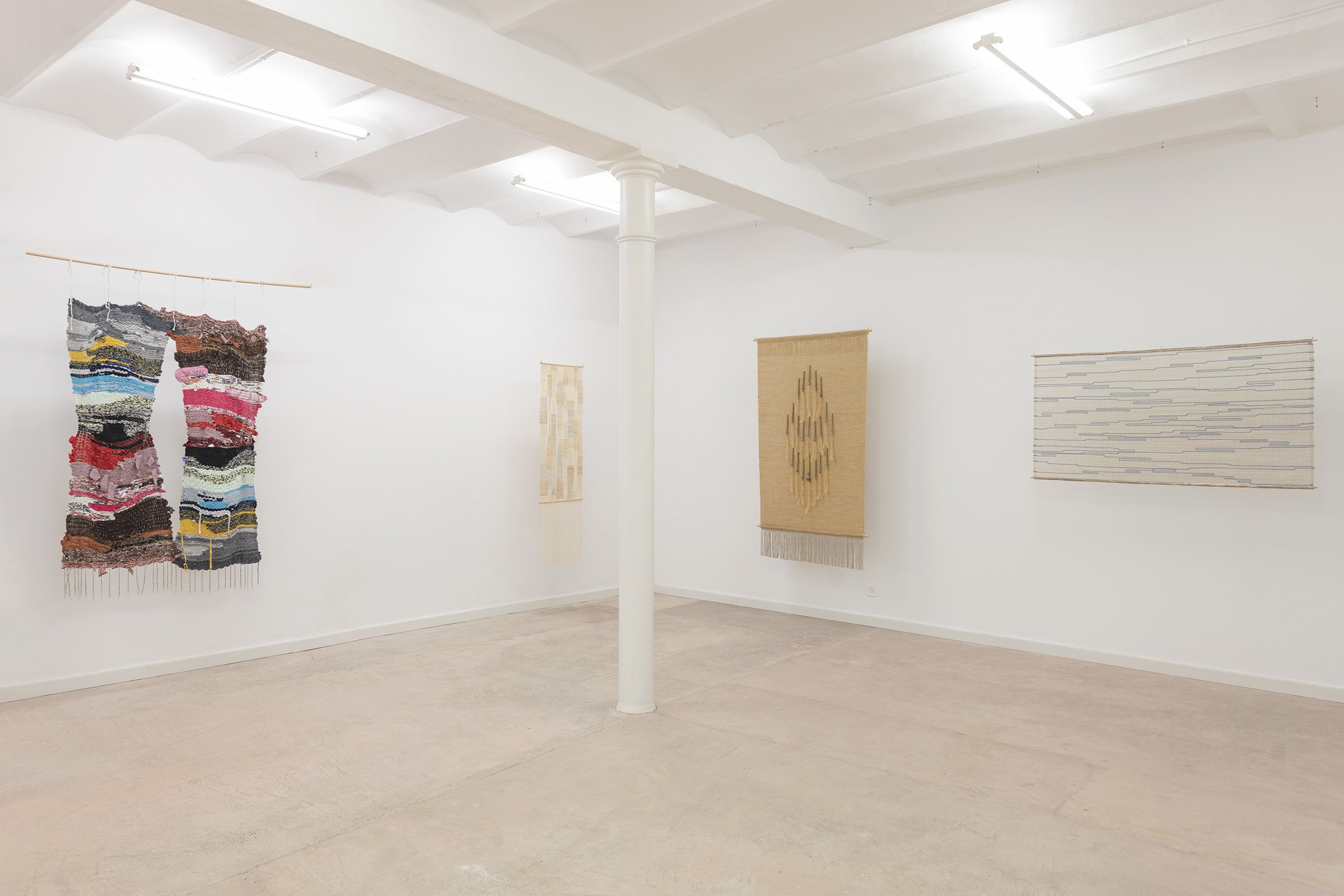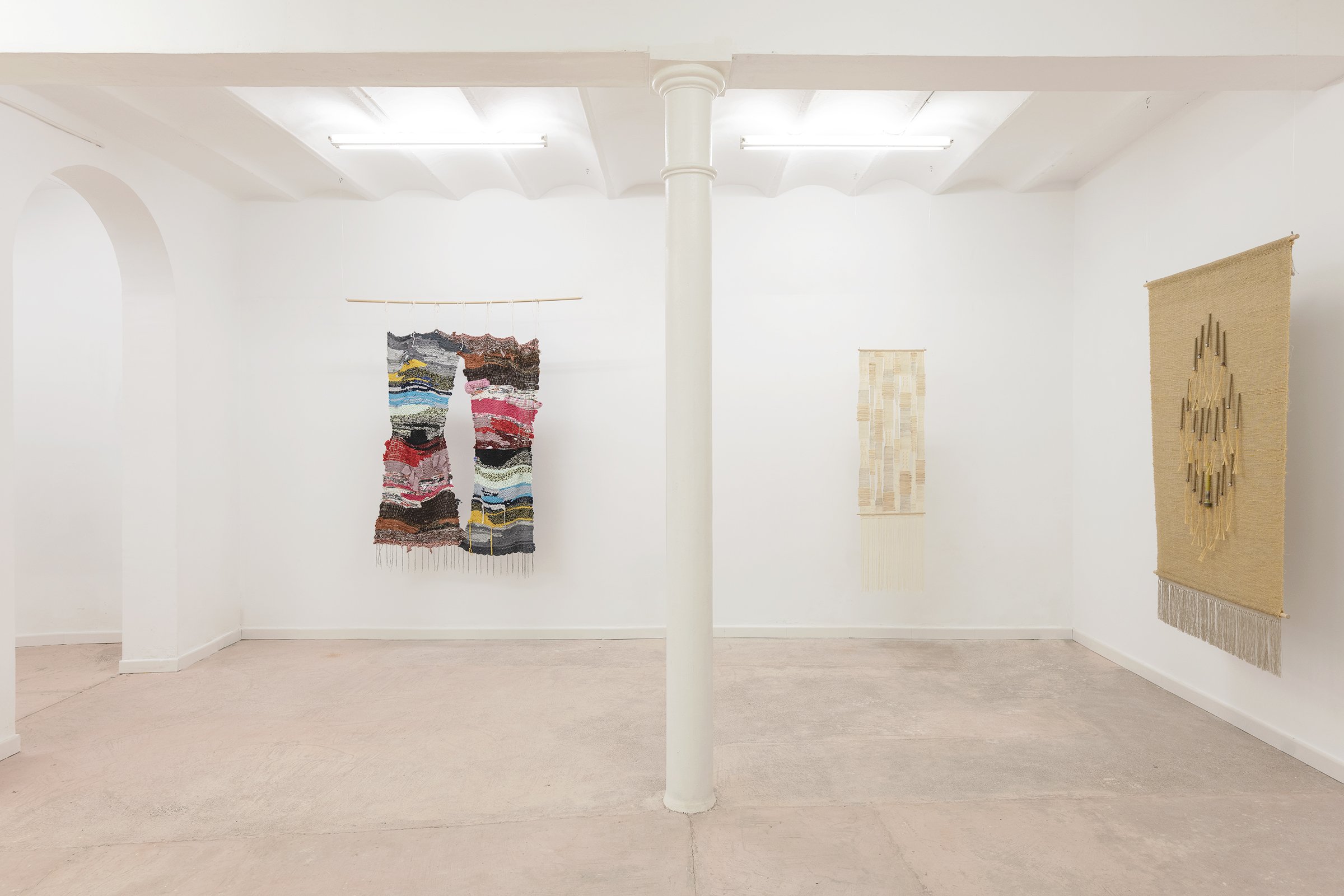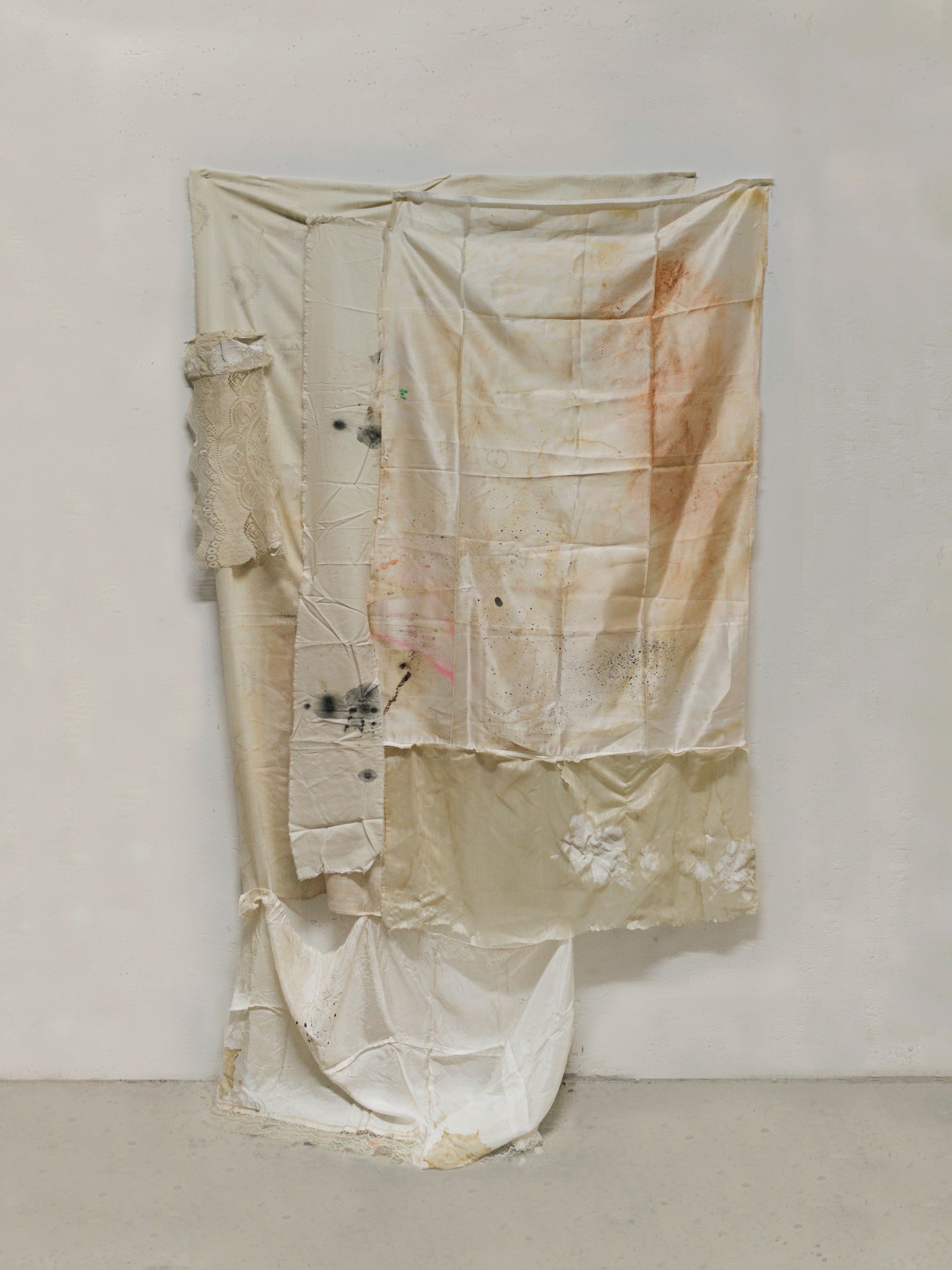
tejiendo identidades
Tejiendo Identidades (Weaving Identities) is a group exhibition that gathers the work of Latin American artists who use their connection with textiles and clothing to explore and express their identities. Through conceptually elaborated and symbolic artworks, they root their oeuvre in their cultural values and traditions, while at the same time paying homage to the new realities they live in the countries where they emigrated.
The exhibition features a selection of artworks from textiles to photography, video, and installation that delve into the symbolic connection between textiles, objects, and clothing. Each piece shows the artists' heritage, reflecting a deep appreciation and respect for their past. The textiles carry stories and symbols passed down through generations, serving as receptacles of history and tradition.
At the heart of this exhibition is the concept of identity—how it is formed, expressed, and transformed. The participating artists, all of whom have emigrated from their home countries, weave their personal narratives into their art. Their works are an amalgamation of their roots and their present experiences, creating a dialogue between their cultural heritage and their lives in new, diverse environments.
Armando Mesías (Cali, Colombia) uses found textiles in an ode to the passage of time and our concept of identity. He intervenes with these fabrics, adding his mark to imbue the pieces with his own identity while honoring the existing stories within them. Pieces like lace, mantilla, silk and cotton are intertwined to create pictorial artworks through the assembly and juxtaposition of layers of fabric. By sewing these pieces together, he pays homage to the act of making textiles and clothing and to the sense of home conveyed by delicate lace.
Cassandra Mayela (Caracas, Venezuela) weaves with already used clothing, meditating on the importance of our garments and how they carry our identity and transmit our ideals and beliefs. The pieces in the exhibition are an elongation of a project presented in New York, where the Venezuelan artist used the clothing worn by Venezuelans when emigrating to the US to shed light on the problems being lived in her home country. With her oeuvre, Cassandra gives beauty and a deeper sense of meaning to clothing pieces otherwise filled with nostalgia and painful moments.
Luis Renteria (Guadalajara, Mexico) is a multidisciplinary artist working with textiles in an ode to materials and their connection with the land. His works pay homage to his Mexican heritage and the materials used in ancestral Mexican cultures, while at the same time highlighting the importance of incorporating new materials found in his new life in Europe. The pieces exhibited in the show are made during his stay at the residency programme in the Hørvævsmuseet museum in Denmark and utilize the materials of the area as well as a myth rooted in Danish tradition.
Silvana Trevale (Caracas, Venezuela) is an award-winning photographer whose work is deeply connected with Latin American culture, particularly focusing on the role played by women and their impact in local communities. For this exhibition, she presents "Cayetana", a series inspired by her grandmother Rosa’s delicate, fragile, and moving story. Silvana initiated this series to preserve her grandmother's legacy through time. Drawing inspiration from her grandmother’s craft of dressmaking, Silvana uses photography and handmade objects to create tangible images that weave together past and present.
The works in Tejiendo Identidades are powerful statements of self-definition and cultural pride. By embracing their ancestors' techniques, motifs and stories, the four exhibiting artists question the homogenizing pressures of the Western world and instead celebrate the uniqueness of their backgrounds, creating art that pays tribute to their origins and reflects their current realities.
This exhibition is a journey through the artists' lives and their evolving identities. It honors their pasts while acknowledging their presents, showing how the act of weaving becomes a metaphor for the complex process of identity formation. Continue reading bellow for an explanation of each one of the projects exhibited.
To request the exhibition catalogue, please send us an email to juliana@julianasorondo.com
armando mesías
For this show Armando Mesías presents a series of evocative, timeworn canvases that blend found fabrics with his own reflections on decay and the passage of time. His work aims to show the marks of past lives and the relentless march of time. Over the years, he has collected various materials, waiting for the right moment to weave them into his art.
Mesías's process is personal and self-referential, yet it thrives on the thrill of finding pieces that belong to different people, eras, and places. He believes his experiences are part of a larger story and brings in other people's anecdotes to make his work more universal and inclusive.
With a deep appreciation for objects and materials, Mesías considers himself a painter focused on the physical presence of his pieces rather than just their visual representation. He constantly looks for ways to bring texture, transparency, and scale into his work. Despite the flatness of layered content, different moments on the canvas create a sense of depth.
In his series, Mesías uses found textiles to honor the passage of time and identity. By adding his mark to these fabrics, he respects their existing stories while infusing them with his own. Delicate materials like lace, mantilla, silk, and cotton are carefully combined to create rich artworks. Sewing these pieces together, Mesías celebrates textile-making and evokes a sense of home and the beauty of lace.
Armando is deeply interested in exploring materials in painting. He finds images less engaging because they often become static symbols, while the changing nature of materials fascinates him more. This transformation reflects how we understand and form our identities. By reshaping or hinting at decay, his interpretation of objects allows for dynamism and change.
He compares this process to dancing, inspired by his native Cali, Colombia, known for its love of salsa. In dance, you have a rough idea of what will happen, but the interaction with a partner—challenging and responding—mirrors his artistic process. Mesías uses unpredictable mediums and techniques, letting them guide his next steps. This approach is not entirely intuitive, but involves setting aside logical thinking to embrace spontaneity and discovery on the canvas.
cassandra mayela Allen
"Maps of Displacement" is a project initiated by Cassandra Mayela Allen in 2021 to explore the Venezuelan diaspora, one of the largest yet most underfunded displacement crises in the world. Over 7 million Venezuelans have emigrated, making it the biggest migration in Western Hemisphere history.
Using fabric and touch, Cassandra tells stories without words. She collects clothes from Venezuelan migrants, cuts them up, and weaves them into tapestries, showing how many small parts come together to form a whole. Through this work, she explores how identity is shaped by the things we carry and the places we live.
So far, Cassandra has interviewed over 200 people, their stories featured in "Maps of Displacement Vol I: NYC 2021" and "Maps of Displacement Vol II: East Coast 2022". The curator of that show, Delgado, called them "objects of embodied memories": textiles made from the clothes of displaced Venezuelans.
Cassandra's work helps people feel part of a community again, even if only symbolically. The project began when she received a uniform from someone’s first official job in the United States. As more stories and clothes came in, the emotional weight became too much, and Cassandra paused the project in 2023.
"Tejiendo Identidades" features two significant pieces by Cassandra. One is a vest made from clothes belonging to members of Rawayana, one of the most popular bands in Venezuela. They wanted to shed light internationally on the immigrant crisis and dedicated a concert to supporting Cassandra's project, with Beto, one of the band members, wearing the vest and discussing the project. The other piece is a sculpture made from various garments collected from Venezuelans, including items from people in Mexico, New York, and Washington, D.C. Although the materials come from immigrants, Cassandra does not consider this piece strictly a "map" as it does not directly reflect a specific city or region.
Overall Cassandra has interviewed about 250 people, a tiny fraction of those who have left. Through "Maps of Displacement," she weaves together pieces of disrupted lives, creating a tapestry that reflects the resilience and identity of the Venezuelan and Latin American diaspora.
luis renteria
This project by Luis Renteria follows his intention of weaving tales and mythology into the fabric of his artistic work. Inspired by these narratives, the materials used pay homage to their origins, blending his Mexican roots with his current European surroundings. Through this poetic fusion, the project captures the essence of place and memory, creating a bridge between cultures and times.
This project is the result of an artistic residency at the Hørvævsmuseet, a weaving and linen museum in Denmark. Fenrir, a small wolf who grew too big from eating too much, became the focus of the gods' attempts to bind him. They tried three times, each represented by a textile interpretation.
The first attempt, Leding (2023), measures 165 x 45 cm. This weaving, with its openwork technique, evokes the tablecloths found in grandmothers' homes, while the strips symbolize chains. The materials include antique cotton and linen in various states: flax stalks, hand-spun linen macerated in grass (grey), hand-spun linen macerated in water (white), machine-spun linen, and paper thread.
The gods then crafted Droma (2023), a stronger weave measuring 180 x 100 cm. Made from linen and agave rope, similar to those used in Denmark to bind large straw silos, it incorporates solid elements such as plastic, cardboard, and metal, interwoven with industrial bobbins from the archive of Hørvævsmuseet.
Despite these efforts, none of the chains could hold Fenrir. So the gods turned to the gnomes, who created Gleipnir (2023), a magical weaving measuring 146 x 80 cm. This third attempt, woven from silk and wool to symbolize the magical in animals, uses a linen structure that acts like a grid, allowing the weft threads to flow freely through the fabric. The ends of the weave gleam like metal, binding the great wolf Fenrir in mythic threads..
silvana trevale
“My grandmother Rosa was my first connection to clothes. Since I was born, she has shared her love by making beautiful dresses for me. I often encounter myself lost in blurred memories of her in my home country of Venezuela, of the days when she used to bath me, hydrate my young skin, and dress me.
Rosa’s mother, Cayetana, was an indigenous black woman who was taken from a young age to serve her own father’s family in the state of Guárico, Venezuela. In that house, she was mistreated by her relatives for her skin colour and due to her bastard origins. Analphabetic and alone with three kids, she took the brave decision to leave her rural home in Altagracia de Orituco and start a new chapter in the capital Caracas, searching for better opportunities.
This book is a love letter to the women of my maternal family tree. With my photographs, I take pride in honouring the unheard story of my lineage. I celebrate the women who have shaped me but that are not physically with me: My great grandmother Cayetana who passed away in 1961, my grandmother Rosa, and my mother Maria, who live in Venezuela.
The photographs play the role of a window to my childhood memories and my family’s journey. They are representations of Cayetana, Rosa, and Maria’s narrated stories. By juxtaposing old family photos buried in dusty shoeboxes inside my grandmother's drawers, with self-portraits and staged images with unrelated models, I recreated aspects of their lives that have influenced my identity. I am the result of their lineage, I will carry their stories through my lifetime.
I initiated this piece due to my desire to weave my grandmother’s Rosa delicate, fragile, and beautiful story to persevere in the passage of time. Inspired by the way she used her craft to give birth to dresses, I use the medium of photography and the craft of handmade objects to create tangible images.
Since I emigrated I have remained connected with home through food and nature. The sea is present throughout the project, perhaps as a childhood memory, a metaphor of the journey, or a symbol of rebirth.
As my childhood was imbued with catholic rituals and folklore tales, and I grew up with the influence of tarot and astrology from my mother, my images carry symbols and themes of religion and magic.
The actions of these women may be seen as ordinary but they have engraved my past and future. In the end, a part of each one of us comes together as a whole in our family portrait.”
Silvana Trevale






















Opening Hours
From Monday to Friday from 11am to 7pm.
C/ de Trafalgar, 32. Ciutat Vella, 08010 Barcelona



